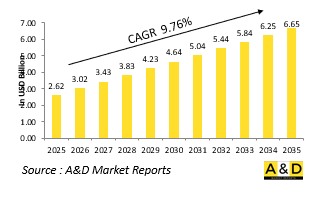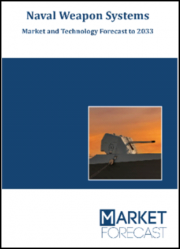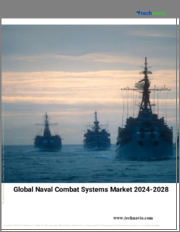
|
시장보고서
상품코드
1735754
세계의 무인 해상 전투 시장(2025-2035년)Global Unmanned Naval Combat Market 2025-2035 |
||||||
전 세계 무인 해상 전투 시장 규모는 2025년에 26억 2,000만 달러로 추정되며, 2035년까지 CAGR 9.76%로 성장하여 66억 5,000만 달러에 달할 것으로 예상됩니다.

무인 해상 전투 시장에서 기술의 영향
기술 혁신은 무인 해상 전투 시스템의 능력과 효율성의 전례 없는 발전을 촉진하고 있습니다. 오늘날의 발전으로 이러한 플랫폼은 자율적으로 작동하고 복잡한 해양 환경을 항해하고 장애물을 피하며 인간의 직접적인 통제 없이도 작전을 수행할 수 있게 되었습니다. 센서 기술의 비약적인 발전으로 위협 감지, 표적 식별, 환경 인식이 강화되어 무인 선박이 실시간으로 중요한 데이터를 수집하고 중계할 수 있게 되었습니다. 통신 시스템은 광대역 보안 링크를 통해 광활한 해상 거리를 지원하도록 진화하여 지휘부 및 동맹군과의 원격 조정 및 데이터 공유를 용이하게 하고 있으며, AI 및 기계 학습 알고리즘이 이러한 시스템에 통합되어 적응형 행동, 예측적 의사결정 및 작전 최적화를 가능하게 하고 있습니다. 또한, 소형화된 전자장비와 효율적인 추진 시스템은 작전 범위와 내구성을 늘리고, 유지보수 필요성을 감소시키고 있습니다. 전자전 스위트와 모듈식 페이로드 베이의 통합을 통해 이러한 플랫폼은 정찰, 공격, 방어 역할을 원활하게 전환할 수 있습니다. 중요한 것은 이러한 시스템이 유인선, 항공기 및 수중 플랫폼과 함께 작동하도록 설계되어 통합된 전투 환경을 조성하고 있다는 점입니다. 기술의 영향은 해군의 작전 수행 방식을 재구성할 뿐만 아니라, 진화하는 해전 무대에서 전력 전개, 위협과의 교전, 해상 상황 통제에 대한 전략적 사고를 재정의하고 있습니다.
무인 해상 전투 시장의 주요 추진 요인
해양 안보 문제가 점점 더 복잡해지면서 전 세계 방산업계가 무인 해상 전투 시스템을 도입하는 데 박차를 가하고 있습니다. 분쟁이 자주 발생하는 광활한 해역에서 인력을 고위험 환경에 노출시키지 않고도 지속적인 감시와 억지력을 유지해야 한다는 점이 주요 요인입니다. 이러한 시스템은 평시 순찰과 활발한 전투 시나리오 모두에서 운영할 수 있는 유연성을 갖추고 있으며, 작전 프로파일의 변화에 대한 적응력이 뛰어납니다. 무인 시스템은 일반적으로 배치 및 유지보수에 필요한 자원이 적기 때문에 기존 해군 함대와 관련된 운영 비용을 절감하고자 하는 욕구도 무인 시스템의 매력에 일조하고 있습니다. 중요한 해상 교통로, 영해, 해저 자원을 둘러싼 지정학적 긴장과 경쟁은 첨단 해상 능력의 중요성을 강조하며 무인 플랫폼에 대한 투자를 가속화하고 있습니다. 분산형 해상 작전으로의 전환은 비대칭 위협에 신속하게 대응할 수 있는 네트워크화된 민첩하고 확장 가능한 시스템의 필요성을 더욱 강조하고 있습니다. 또한, 정책의 진화는 해군의 통합 및 연합 작전에 무인 시스템을 통합하여 상호 운용성과 전략적 도달 범위를 강화하는 것이 중요하다는 점을 분명히 하고 있습니다. 정찰, 공격, 기뢰제거 작전을 단독으로 또는 유인 자산과 함께 수행할 수 있는 능력으로 인해 이러한 플랫폼은 다목적성, 생존성, 신속한 대응에 대한 수요에 힘입어 미래 해양 전략의 핵심으로 확고히 자리매김하고 있습니다.
무인 해상 전투 시장 지역별 동향
전 세계 방산 부문은 무인 해상 전투 시스템의 전략적 잠재력을 점점 더 인식하고 있으며, 지역별 동향은 안보 우려와 해역 지리에 기반한 다양한 우선순위를 반영하고 있습니다. 아시아태평양에서는 연안 분쟁과 해역 인식의 필요성 때문에 자율 지상 및 수중 플랫폼에 대한 투자가 활발히 이루어지고 있습니다. 광활한 해안선과 활발한 항로를 가진 국가들은 해상 통제를 보장하기 위해 감시 능력과 대잠 능력에 중점을 두고 있습니다. 북미, 특히 미국은 장거리 작전, 정보 수집, 정밀 교전에 중점을 두고 기존 해군력을 보완하는 통합형 무인 함대 구축을 목표로 하고 있습니다. 유럽 국가들은 모듈식 설계와 상호운용성에 중점을 둔 공동 개발 프로그램을 추진하여 국내 및 연합군 주도의 작전을 모두 지원하고 있습니다. 이러한 접근 방식에는 해적 행위에서 영토 침범에 이르기까지 다양한 위협에 대응하기 위해 수상 시스템과 수중 시스템을 결합하는 것도 포함됩니다.
세계의 무인 해상 전투 시장에 대해 조사 분석했으며, 성장 촉진요인, 향후 10년간의 전망, 지역별 동향 등의 정보를 전해드립니다.
목차
무인 해상 전투 시장 보고서의 정의
무인 해상 전투 시장 세분화
유도별
유형별
지역별
향후 10년간 무인 해상 전투 시장 분석
무인 해상 전투 시장 기술
세계의 무인 해상 전투 시장 예측
지역의 무인 해상 전투 시장 동향과 예측
북미
촉진요인, 억제요인, 과제
PEST
시장 예측과 시나리오 분석
주요 기업
공급업체 Tier 상황
기업 벤치마크
유럽
중동
아시아태평양
남미
무인 해상 전투 시장 분석 : 국가별
미국
방위 프로그램
최신 뉴스
특허
이 시장의 현재 기술 성숙도
시장 예측과 시나리오 분석
캐나다
이탈리아
프랑스
독일
네덜란드
벨기에
스페인
스웨덴
그리스
호주
남아프리카공화국
인도
중국
러시아
한국
일본
말레이시아
싱가포르
브라질
무인 해상 전투 시장 기회 매트릭스
무인 해상 전투 시장 보고서에 관한 전문가의 의견
결론
Aviation and Defense Market Reports 소개
ksm 25.06.12The Global Unmanned Naval Combat market is estimated at USD 2.62 billion in 2025, projected to grow to USD 6.65 billion by 2035 at a Compound Annual Growth Rate (CAGR) of 9.76% over the forecast period 2025-2035.

Introduction to Unmanned Naval Combat Market:
Unmanned naval combat systems are transforming maritime warfare by introducing autonomy, precision, and persistent presence into naval operations without endangering human crews. These systems, which include surface and underwater vehicles, offer a range of strategic advantages-conducting surveillance, mine countermeasures, electronic warfare, and even offensive strikes. As naval domains become increasingly contested, defense forces are turning to unmanned platforms to extend operational reach, monitor vast maritime regions, and respond to threats more swiftly. Unlike traditional vessels, unmanned systems can operate for prolonged durations, often in environments too dangerous or remote for manned crews. They can also be deployed in swarms or coordinated units, offering layered and adaptive maritime defense. Global interest in these capabilities is expanding, with militaries seeking to modernize their fleets and adopt technologies that support multidomain operations. The development of these systems reflects a strategic shift in naval doctrine-prioritizing versatility, survivability, and real-time intelligence. As threats at sea become more complex, nations are investing in unmanned naval combat solutions to enhance deterrence, protect trade routes, and ensure maritime dominance. These platforms are no longer peripheral; they are becoming essential components of future naval warfare, seamlessly integrating with traditional assets and contributing to a more agile and resilient maritime force.
Technology Impact in Unmanned Naval Combat Market:
Technological innovation is driving unprecedented progress in the capabilities and effectiveness of unmanned naval combat systems. Modern advancements have enabled these platforms to operate autonomously, navigating complex maritime environments, avoiding obstacles, and executing missions without direct human control. Breakthroughs in sensor technologies have enhanced threat detection, target identification, and environmental awareness, allowing unmanned vessels to gather and relay critical data in real time. Communication systems have evolved to support secure, high-bandwidth links across vast ocean distances, facilitating remote coordination and data sharing with command centers and allied units. Artificial intelligence and machine learning algorithms are now embedded into these systems, enabling adaptive behaviors, predictive decision-making, and mission optimization. In addition, miniaturized electronics and efficient propulsion systems are extending operational range and endurance while reducing maintenance requirements. The integration of electronic warfare suites and modular payload bays allows these platforms to transition seamlessly between surveillance, offensive, and defensive roles. Importantly, these systems are being designed to collaborate with manned vessels, aircraft, and underwater platforms, creating a connected and cohesive combat environment. The technological impact is not only reshaping how naval forces conduct operations but also redefining strategic thinking about force deployment, threat engagement, and maritime situational dominance in the evolving theater of naval warfare.
Key Drivers in Unmanned Naval Combat Market:
The increasing complexity of maritime security challenges is fueling the adoption of unmanned naval combat systems across global defense communities. A major driver is the need to maintain persistent surveillance and deterrence across vast and often contested maritime regions without exposing personnel to high-risk environments. These systems offer the flexibility to operate in both peacetime patrols and active combat scenarios, making them highly adaptable to changing mission profiles. The desire to reduce the operational costs associated with traditional naval fleets also contributes to their appeal, as unmanned systems generally require fewer resources to deploy and sustain. Geopolitical tensions and competition over critical sea lanes, territorial waters, and undersea resources have underscored the importance of advanced maritime capabilities, prompting accelerated investment in unmanned platforms. The shift toward distributed maritime operations has further highlighted the need for networked, agile, and scalable systems that can respond swiftly to asymmetric threats. Additionally, evolving doctrines emphasize the importance of integrating unmanned systems into joint and coalition naval operations, enhancing interoperability and strategic reach. The ability to carry out reconnaissance, strike, and mine-clearing missions independently or in tandem with crewed assets has solidified these platforms as a cornerstone of future naval strategy, driven by the demand for versatility, survivability, and rapid response.
Regional Trends in Unmanned Naval Combat Market:
Global defense sectors are increasingly recognizing the strategic potential of unmanned naval combat systems, and regional trends reflect diverse priorities based on security concerns and maritime geography. In the Asia-Pacific region, coastal disputes and the need for maritime domain awareness are prompting significant investment in autonomous surface and underwater platforms. Nations with expansive coastlines and active shipping routes are focusing on surveillance and anti-submarine capabilities to ensure maritime control. In North America, particularly the United States, efforts are directed toward building integrated unmanned fleets that complement existing naval power, emphasizing long-range operations, intelligence gathering, and precision engagement. European countries are pursuing cooperative development programs, focusing on modular designs and interoperability to support both national and alliance-led missions. Their approach often includes combining surface and underwater systems to address a range of threats, from piracy to territorial incursion. In the Middle East, unmanned naval systems are being adopted to secure ports, monitor vital chokepoints, and conduct persistent patrols around key maritime infrastructure. African and Latin American regions are gradually exploring unmanned capabilities for coastal security and counter-smuggling operations, often in partnership with more established defense producers. Across all regions, the common thread is a growing emphasis on autonomy, adaptability, and integration into broader maritime defense architectures.
Key Unmanned Naval Combat Program:
HD Hyundai Heavy Industries (HD HHI), in collaboration with the Republic of Korea (ROK) Navy, is advancing the development of a naval combat unmanned surface vessel (USV), seen as a potential game-changer in future maritime operations. Designed to operate in frontline areas, the combat USV will undertake reconnaissance and close-combat missions, effectively reducing the need for manned vessels. It is expected to play a central role in future manned-unmanned teaming systems at sea. HD HHI plans to hold a kickoff meeting later this month and will spend the next eight months on concept design, aiming to complete this phase by December. The work will define the combat USV's performance requirements, key technologies, and procurement strategies. With this initiative, HD HHI intends to propose mission solutions tailored to future multi-domain warfare, while developing a USV that surpasses current manned platforms in reliability and cost-efficiency. The company has reaffirmed its commitment to leading the advancement of integrated manned-unmanned systems, starting with this project.
Table of Contents
Unmanned Naval Combat Market Report Definition
Unmanned Naval Combat Market Segmentation
By Guidance
By Type
By Region
Unmanned Naval Combat Market Analysis for next 10 Years
The 10-year Unmanned Naval Combat Market analysis would give a detailed overview of mortar ammunition market growth, changing dynamics, technology adoption overviews and the overall market attractiveness is covered in this chapter.
Market Technologies of Unmanned Naval Combat Market
This segment covers the top 10 technologies that is expected to impact this market and the possible implications these technologies would have on the overall market.
Global Unmanned Naval Combat Market Forecast
The 10-year Unmanned Naval Combat Market forecast of this market is covered in detailed across the segments which are mentioned above.
Regional Unmanned Naval Combat Market Trends & Forecast
The regional Unmanned Naval Combat Market trends, drivers, restraints and Challenges of this market, the Political, Economic, Social and Technology aspects are covered in this segment. The market forecast and scenario analysis across regions are also covered in detailed in this segment. The last part of the regional analysis includes profiling of the key companies, supplier landscape and company benchmarking. The current market size is estimated based on the normal scenario.
North America
Drivers, Restraints and Challenges
PEST
Market Forecast & Scenario Analysis
Key Companies
Supplier Tier Landscape
Company Benchmarking
Europe
Middle East
APAC
South America
Country Analysis of Access Control Market
This chapter deals with the key defense programs in this market, it also covers the latest news and patents which have been filed in this market. Country level 10 year market forecast and scenario analysis are also covered in this chapter.
US
Defense Programs
Latest News
Patents
Current levels of technology maturation in this market
Market Forecast & Scenario Analysis
Canada
Italy
France
Germany
Netherlands
Belgium
Spain
Sweden
Greece
Australia
South Africa
India
China
Russia
South Korea
Japan
Malaysia
Singapore
Brazil
Opportunity Matrix for Unmanned Naval Combat Market
The opportunity matrix helps the readers understand the high opportunity segments in this market.
Expert Opinions on Unmanned Naval Combat Market Report
Hear from our experts their opinion of the possible analysis for this market.















